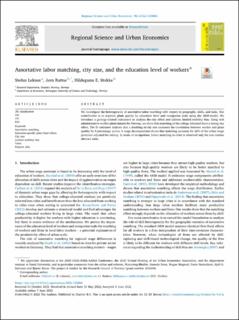Assortative labor matching, city size, and the education level of workers
Peer reviewed, Journal article
Published version
Date
2022Metadata
Show full item recordCollections
- Artikler / Journal articles [426]
- Publikasjoner fra Cristin [138]
Original version
Regional Science and Urban Economics. 2022, 22 . https://doi.org/10.1016/j.regsciurbeco.2022.103806Abstract
We investigate the heterogeneity of assortative labor matching with respect to geography, skills, and tasks. Our contribution is to separate plant quality by education level and occupation tasks using the AKM-model. We introduce a geology-related instrument to analyze the city effect and address limited mobility bias. Using rich administrative worker-plant dataset for Norway, we show that matching of the college educated have a strong city effect. The IV estimates indicate that a doubling of city size increases the correlation between worker and plant quality by 9 percentage points. A wage decomposition shows that matching accounts for 22% of the urban wage premium adjusted for sorting. In terms of occupations, better matching in cities is observed only for non-routine abstract tasks.

